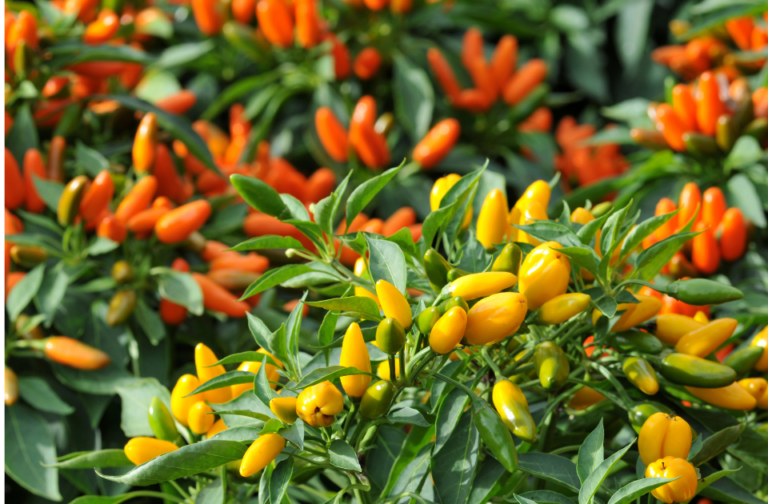Looking to add a vibrant splash of color to your garden? Decorative peppers are the perfect choice! These stunning plants offer a range of striking colors and are relatively easy to care for, making them ideal for both experienced gardeners and beginners. In this guide, you’ll learn everything about growing, caring for, and using ornamental peppers in your garden or home.
What Are Ornamental Peppers?
Decorative peppers (Capsicum annuum) are small, brightly colored peppers that are primarily grown for decorative purposes. You can spot these peppers in various hues like red, yellow, orange, purple, and black. They are particularly popular in gardens during the fall, as their bright fruits add a vibrant contrast to other seasonal plants.
While these peppers are edible, they are generally grown for their aesthetic value. Their taste can be extremely hot and sometimes bitter, so they’re more often used as a visual statement. For more fun facts about these colorful plants, check out this resource on ornamental pepper facts.
Types of Ornamental Peppers
There are many varieties of ornamental peppers, each with its unique features. Some popular types include:
- Black Pearl: Known for its striking black fruits that turn red when mature.
- Chilly Chili: Features a mix of red, yellow, and orange peppers.
- Sangria: Displays small, vibrant purple peppers that mature to red.
- Bolivian Rainbow: A colorful variety with peppers in shades of purple, orange, and red.
These varieties make excellent additions to both outdoor and indoor gardens, adding bursts of color in containers, pots, or garden beds. For more planting ideas and tips on using peppers in landscapes, check out this article on companion planting.
Ideal Growing Conditions for Ornamental Peppers
To grow healthy and vibrant ornamental peppers, you need to provide the right conditions:
- Light: These plants require full sun, with at least 6 hours of direct sunlight each day.
- Soil: Well-drained soil with a slightly acidic to neutral pH level is ideal.
- Watering: Water consistently, keeping the soil moist but not waterlogged. Be careful to avoid overwatering as it can lead to root rot.
- Temperature: Ornamental peppers thrive in temperatures between 70°F and 85°F (21°C to 29°C). They are sensitive to frost, so bring them indoors when temperatures drop below 50°F (10°C).
Planting Colorful pepper
Whether you’re planting in containers or directly in the garden, here’s how to get started:
- Choose the right variety: Select a variety that suits your garden or indoor decor.
- Prepare the soil: Mix compost or organic matter to improve soil drainage and fertility.
- Plant at the right time: In colder climates, plant your peppers in the spring after the last frost. If growing indoors, plant year-round as long as there’s enough sunlight.
- Spacing: Keep plants 12-18 inches apart for proper air circulation and growth.
If starting from seeds, you can sow them indoors 8-10 weeks before the last frost. For tips on starting plants from seeds, check out this comprehensive guide on tomatoes.
Caring for Ornamental Peppers Throughout the Season
To ensure your ornamental peppers thrive all season, follow these care tips:
- Fertilization: Use a balanced fertilizer once a month to boost growth and fruit production.
- Pruning: Regularly prune dead or yellowing leaves to encourage new growth and healthy plants.
- Pest Management: Look out for pests like aphids, spider mites, and whiteflies. Use neem oil or insecticidal soap to manage infestations.
For more in-depth pest management, see this guide on controlling aphids, which is also applicable to pepper plants.
Harvesting and Edibility of Ornamental Peppers
While Colorful pepper plants are technically edible, they are often much hotter than culinary varieties and can taste quite bitter. If you want to harvest them:
- When to harvest: Pick the peppers when they are fully ripe and have reached their final color, typically red, orange, or purple.
- Caution: Be careful when handling the fruits, as they can cause skin irritation due to their heat. Always wash your hands after harvesting.
Using Ornamental Peppers in Landscaping
The striking colors of ornamental peppers make them a fantastic addition to any landscape. Here’s how you can incorporate them into your garden design:
- Borders and edging: Use these plants to line walkways, borders, or garden beds for a burst of color.
- Containers and pots: Due to their compact size, ornamental peppers look great in containers or hanging baskets, brightening up patios and porches.
- Seasonal displays: Combine ornamental peppers with other fall plants like chrysanthemums or kale to create stunning seasonal arrangements.
For more garden layout ideas, explore this guide on creating themed gardens.
FAQs About Colorful pepper plants
Can you eat ornamental peppers?
Yes, but they tend to be very hot and sometimes bitter. Use them sparingly if you choose to cook with them.
How long do Colorful pepper plants live?
In warm climates, ornamental peppers can live as perennials. In cooler climates, they are typically grown as annuals.
Are ornamental peppers toxic to pets?
Yes, the fruits of ornamental peppers can be toxic to pets if ingested, so it’s best to keep them out of reach.
Ornamental peppers are not only beautiful but also versatile plants that can brighten up your garden or indoor spaces. Whether you’re using them as part of a fall display or year-round decor, these colorful peppers add a striking visual element to any space.
For more tips and inspiration on gardening, be sure to check out related topics like growing garden mums and caring for pansies for a complementary fall garden.
